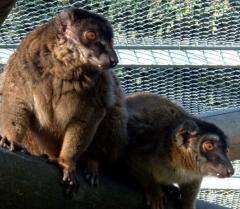What are you looking at?

(PhysOrg.com) -- Why do we look when another person looks? Are we looking for objects of interest or perhaps a warning of impending danger? Or are we just plain nosey? Human tendency to follow another person's gaze - `gaze following' - can be traced back to man's most distant relatives, according to a new scientific report.
Researchers at the University of St Andrews have found evidence that the action is a primitive cognitive skill dating back to the time of the first primates.
Psychologists April Ruiz, Juan Carlos Gomez and Richard Byrne also believe they have solved the evolutionary paradox of why animals such as dogs can follow their master¿s gaze to find rewards, yet our closest relatives apparently can't.
Professor Byrne said, "Humans find it impossible not to look up when they see someone staring upwards at the sky, even when they know it might be a trick. We are not alone in this habit: it's been known for some years that several species of non-human primates, apes and monkeys, show the same tendency to follow gaze. But when their ability to use this to find useful information (for example, where food is hidden) has been tested, they generally failed."
Dr Gomez added, "The ability to track gaze makes excellent sense for a social animal like a primate, because it can give clues about foods to eat, predators to avoid, social scenarios to take note of and so on. Up to now, the abilities of non-human primates to interpret gaze have puzzled scientists - the paradox being, what is the point of gaze following if it isn't used for basic functions such as locating resources?"
The St Andrews team studied the lemur - a primate so distantly related to humans they look more like cats than monkeys - for clues. The new study reports what others have failed to find - that lemurs have the ability to intelligently respond to the gaze of another, by using it to find objects of interest.
"Because we have found this ability, once thought unique to humans, in lemurs, we can push back the date of its original evolution far beyond the last common ancestor we share with apes, or even with monkeys, back to the time of the first primates," commented April Ruiz.
The St Andrews' team worked alongside Jean Jacques Roeder at the Centre de Primatologie de l'Université Louis Pasteur in Strasbourg. The researchers carried out a combined study of the two elements, `gaze and search' - something that had surprisingly not been done before. They found that whenever a lemur looked at a location signalled by gaze, it was most likely to choose that location to search for food. In contrast to previous tests with primates, the lemurs were able to use gaze to increase their chance of finding food.
The researchers stress that they are not claiming human-like mental abilities in lemurs. "We call the process gaze priming," explained Professor Byrne. "Following another's gaze draws an animal's attention to a place, and if it is the sort of place where food is found, then the animal will be more likely to search there; if it was the sort of place danger lurks, the animal could choose to do the opposite and keep away from it."
Dr Gomez added, "To benefit from gaze priming the animal doesn¿t need to understand anything about the minds of those whose gaze it follows. Our own, human understanding of attention is built on these simple but useful foundations. Humans have evolved to more complex gaze following, resulting in more flexible behavioural responses."
"Our study helps us understand how we might interpret the gaze of another, concluded April Ruiz. When you're gossiping about someone, and your partner suddenly stares over your shoulder...could it be the topic of your gossip has just appeared? You are walking in the hills and notice your friends are all looking one way. Have they seen an escaped puma? Or just approaching rain? The point is that gazing may not be intended to help anyone - but it does, because we can read it and follow the direction, whatever it is aimed at."
The results of the study are published in the journal Animal Cognition, ref DOI 00.1007/s10071-008-0202-z
Provided by University of St Andrews
















